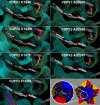Characterization of poliovirus variants selected for resistance to the antiviral compound V-073
- PMID: 22890765
- PMCID: PMC3486616
- DOI: 10.1128/AAC.00539-12
Characterization of poliovirus variants selected for resistance to the antiviral compound V-073
Abstract
V-073, a small-molecule capsid inhibitor originally developed for nonpolio enterovirus indications is considerably more potent against polioviruses. All poliovirus isolates tested to date (n = 45), including wild, vaccine, vaccine-derived, and laboratory strains, are susceptible to the antiviral capsid inhibitor V-073. We grew poliovirus in the presence of V-073 to allow for the identification of variants with reduced susceptibility to the drug. Sequence analysis of 160 independent resistant variants (80 isolates of poliovirus type 1, 40 isolates each of types 2 and 3) established that V-073 resistance involved a single amino acid change in either of two virus capsid proteins, VP1 (67 of 160 [42%]) or VP3 (93 of 160 [58%]). In resistant variants with a VP1 change, the majority (53 of 67 [79%]) exhibited a substitution of isoleucine at position 194 (equivalent position 192 in type 3) with either methionine or phenylalanine. Of those with a VP3 change, alanine at position 24 was replaced with valine in all variants (n = 93). The resistance phenotype was relatively stable upon passage of viruses in cell culture in the absence of drug. Single-step growth studies showed no substantial differences between drug-resistant variants and the virus stocks from which they were derived, while the resistant viruses were generally more thermally labile than the corresponding drug-susceptible parental viruses. These studies provide a foundation from which to build a greater understanding of resistance to antiviral compound V-073.
Figures



Similar articles
-
H1PVAT is a novel and potent early-stage inhibitor of poliovirus replication that targets VP1.Antiviral Res. 2014 Oct;110:1-9. doi: 10.1016/j.antiviral.2014.07.003. Epub 2014 Jul 17. Antiviral Res. 2014. PMID: 25043639
-
Anti-poliovirus activity of protease inhibitor AG-7404, and assessment of in vitro activity in combination with antiviral capsid inhibitor compounds.Antiviral Res. 2013 May;98(2):186-91. doi: 10.1016/j.antiviral.2013.03.003. Epub 2013 Mar 13. Antiviral Res. 2013. PMID: 23499651
-
Immunological and pathogenic properties of poliovirus variants selected for resistance to antiviral drug V-073.Antivir Ther. 2011;16(7):999-1004. doi: 10.3851/IMP1838. Antivir Ther. 2011. PMID: 22024515
-
My Cousin, My Enemy: quasispecies suppression of drug resistance.Curr Opin Virol. 2016 Oct;20:106-111. doi: 10.1016/j.coviro.2016.09.011. Epub 2016 Oct 17. Curr Opin Virol. 2016. PMID: 27764731 Free PMC article. Review.
-
Ribavirin and lethal mutagenesis of poliovirus: molecular mechanisms, resistance and biological implications.Virus Res. 2005 Feb;107(2):173-81. doi: 10.1016/j.virusres.2004.11.007. Virus Res. 2005. PMID: 15649563 Review.
Cited by
-
Dominant drug targets suppress the emergence of antiviral resistance.Elife. 2014 Nov 3;3:e03830. doi: 10.7554/eLife.03830. Elife. 2014. PMID: 25365453 Free PMC article.
-
Antiviral Development for the Polio Endgame: Current Progress and Future Directions.Pathogens. 2024 Nov 6;13(11):969. doi: 10.3390/pathogens13110969. Pathogens. 2024. PMID: 39599522 Free PMC article. Review.
-
Stem Cell Transplant in Immune-deficiency-associated Vaccine-derived Poliovirus.Open Forum Infect Dis. 2024 Jan 17;11(2):ofad678. doi: 10.1093/ofid/ofad678. eCollection 2024 Feb. Open Forum Infect Dis. 2024. PMID: 38328499 Free PMC article.
-
A single chimpanzee-human neutralizing monoclonal antibody provides post-exposure protection against type 1 and type 2 polioviruses.J Clin Virol. 2015 Apr;65:32-7. doi: 10.1016/j.jcv.2015.01.023. Epub 2015 Feb 3. J Clin Virol. 2015. PMID: 25766984 Free PMC article.
-
Characterization of Poliovirus Neutralization Escape Mutants of Single-Domain Antibody Fragments (VHHs).Antimicrob Agents Chemother. 2015 Aug;59(8):4695-706. doi: 10.1128/AAC.00878-15. Epub 2015 May 26. Antimicrob Agents Chemother. 2015. PMID: 26014941 Free PMC article.
References
-
- Alexander LN, et al. 2004. Vaccine policy changes and epidemiology of poliomyelitis in the United States. JAMA 292:1696–1701 - PubMed
-
- Anonymous 2005. Cessation of routine oral polio vaccine (OPV) use after global polio eradication: framework for national policy makers in OPV-using countries, p 12 World Health Organization, Geneva, Switzerland
-
- Collett MS, Neyts J, Modlin JF. 2008. A case for developing antiviral drugs against polio. Antivir. Res. 79:179–187 - PubMed
-
- Committee on Development of a Polio Antiviral and Its Potential Role in Global Poliomyelitis Eradication 2006. Exploring the role of antiviral drugs in the eradication of polio. National Research Council, Washington, DC
Publication types
MeSH terms
Substances
LinkOut - more resources
Full Text Sources

